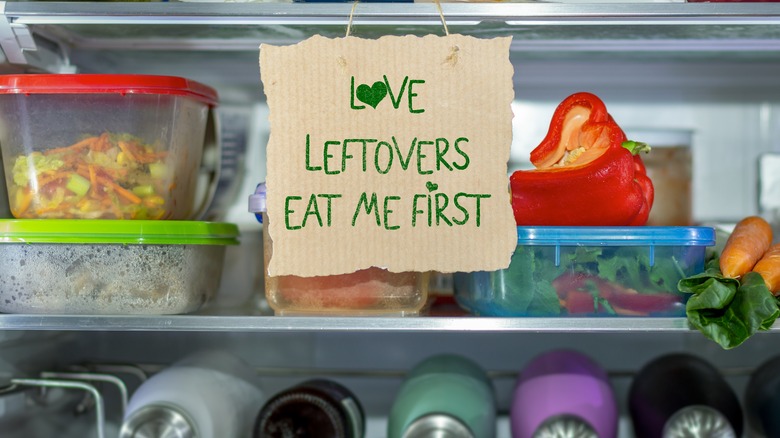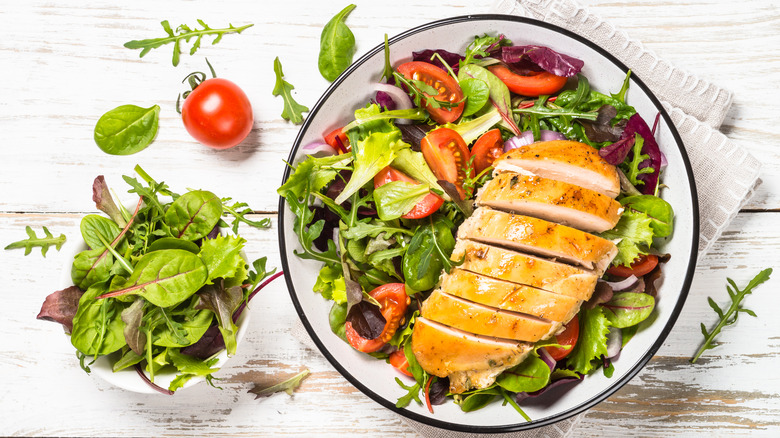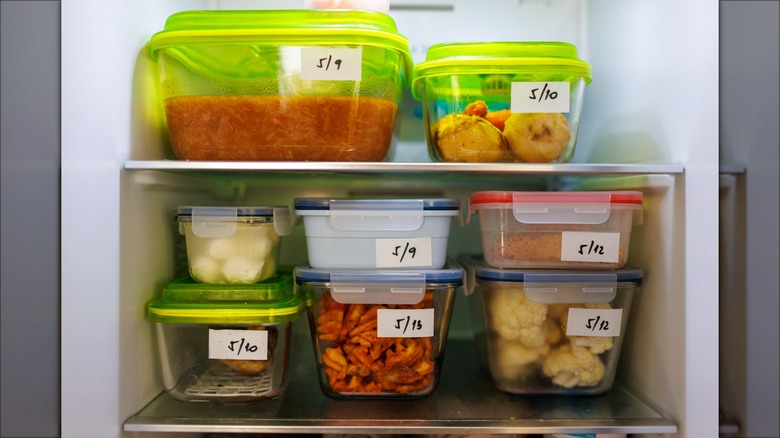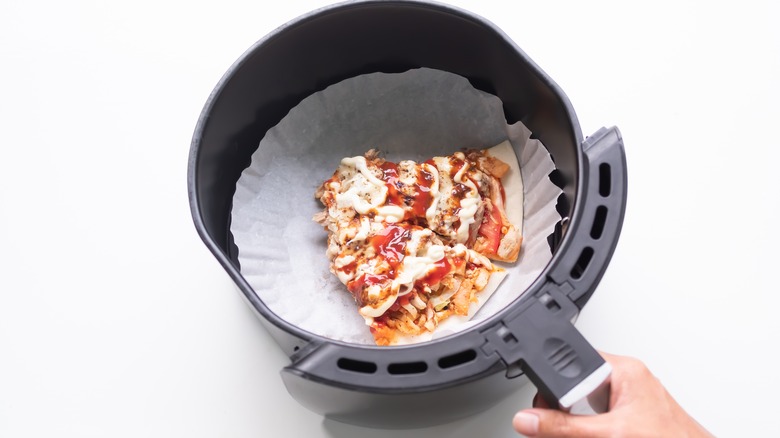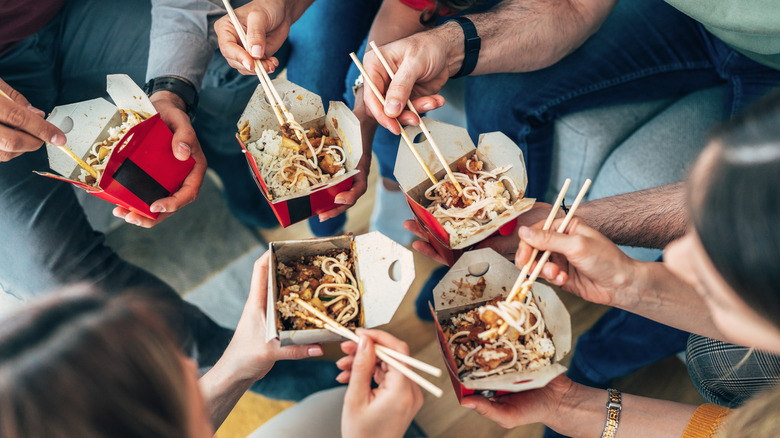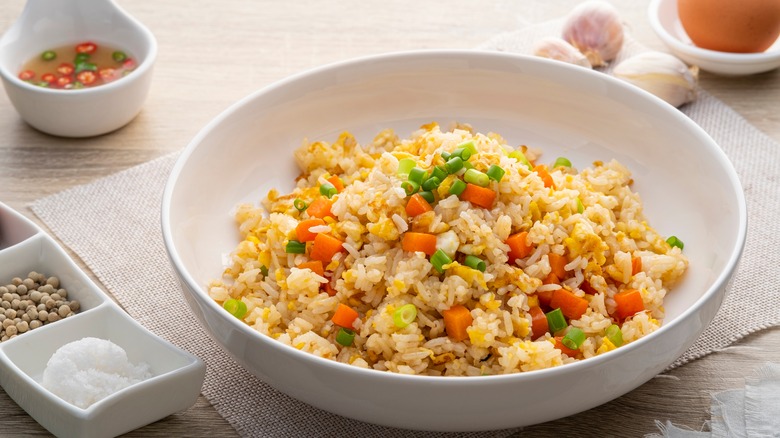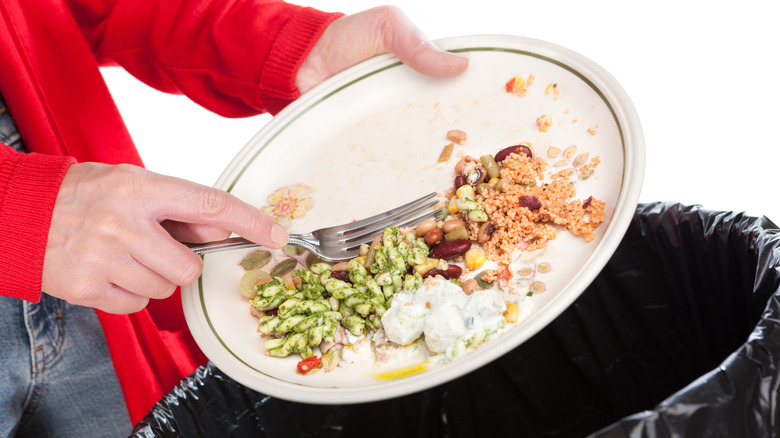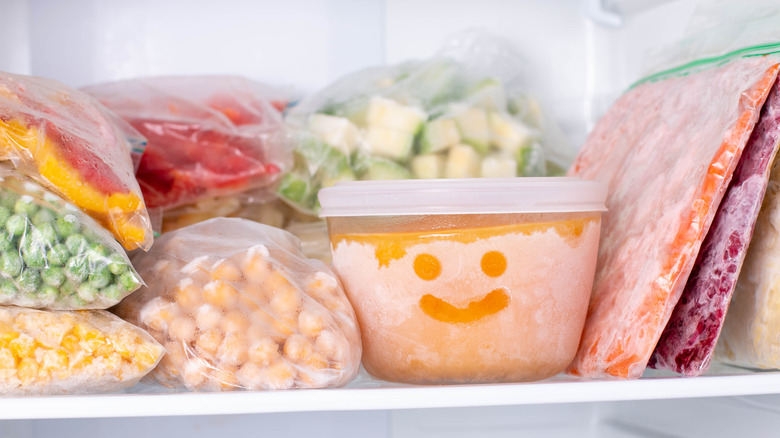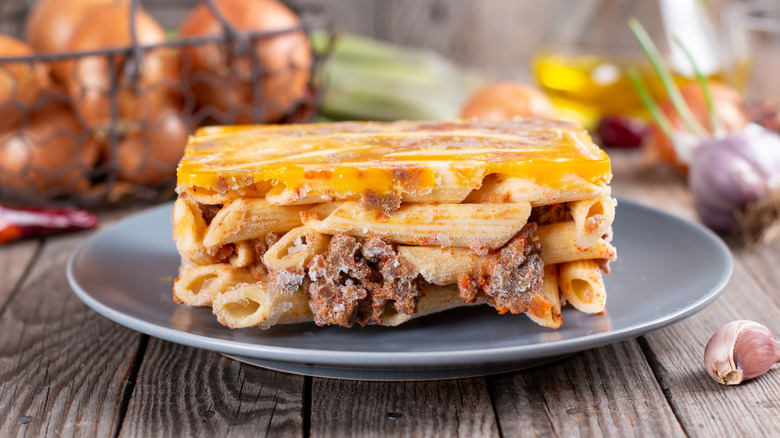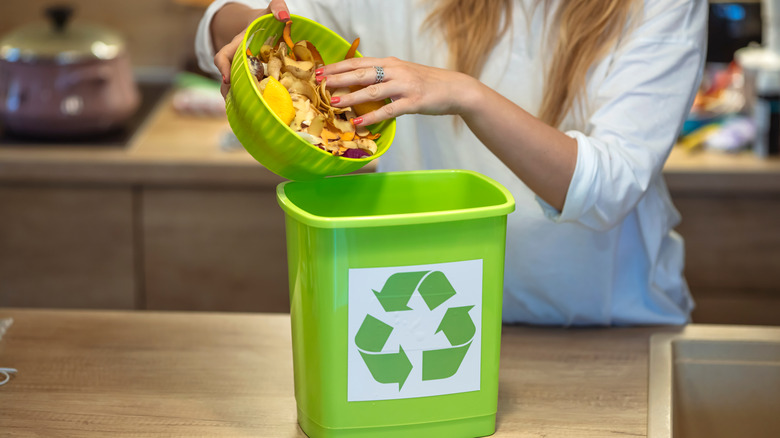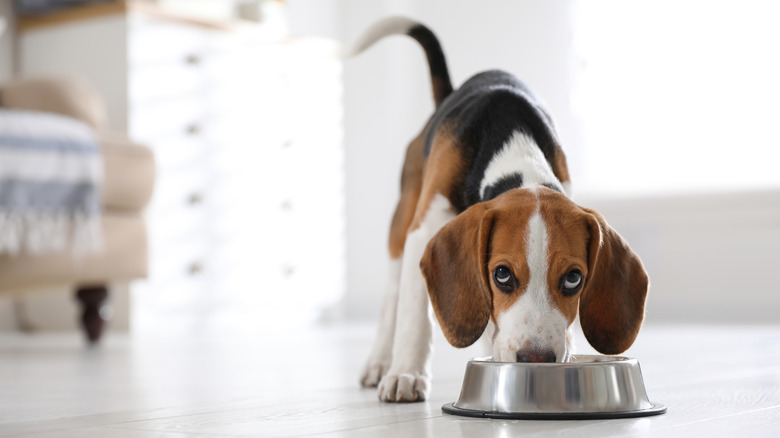10 Mistakes You Should Avoid With Leftovers
After cooking a meal or dining out in a restaurant, you're often left with some extra food. Saving this food for a future meal allows you to enjoy the recipes you prepared or ordered a second or sometimes third time. At the same time, it provides you with a quick and easy meal to enjoy that requires minimal prep work.
While leftovers can certainly simplify life, there are several mistakes people make with them. Some of these mistakes can cause the food to spoil or start to grow bacteria, increasing the chances that someone will get food poisoning when they eat it. Other mistakes can have a negative impact on the taste or texture of the reheated leftovers, making them far less appetizing than when they were freshly cooked. Continue reading to learn more about these and other common mistakes people make with their leftovers so you can avoid making them with yours.
Not refrigerating them soon enough
When you have leftover food, it is important to get it in the refrigerator quickly. If food is left out at room temperature for more than two hours, it is more likely that the bacteria on it will multiply and reach potentially dangerous levels. The temperature range between 40 and 140 degrees Fahrenheit is referred to as the Danger Zone. When the temperature of your leftovers falls within the range, Salmonella, E. Coli, Staphylococcus, and other bacteria may double up to every 20 minutes.
Remember, the two hours start as soon as the food is cooked — not after you've finished the meal. The same is also true for leftovers from a restaurant. If the food has been out for more than two hours before you can get it into a refrigerator, it isn't a safe choice to try to save it. And, if food is outside in temperatures above 90 degrees Fahrenheit (think about summer barbecues and picnics), it should be refrigerated within one hour to steer clear of the Danger Zone.
Not storing and labeling them properly
Proper storage of your leftovers is essential. Before placing them in the refrigerator, you should put them in an airtight container. Airtight containers will keep the food fresher for longer, ensuring it still tastes as desired when you're ready to eat it. Foods kept in an airtight container will also be more protected against bacteria growth or contamination from odors or drippings of other foods in the fridge. If you plan on bringing your leftovers to work, it will also be easier to transport them in an airtight container without worrying about anything spilling or leaking out in your lunchbox.
Once you've properly packaged your leftover food in an airtight container, there's one more thing you'll want to do before putting it in the refrigerator. Take just a moment to add a label with the date and contents on the container. You can use painter's tape or masking tape stuck on the side of the container for the label. Labels will make it easier for you and the others in your home to scan the refrigerator and know what's there and how old it is.
Finally, instead of just tossing the containers anywhere in your fridge where you can find space, find a way to keep them organized and visible. This will help decrease food waste and ensure you don't forget about something until it is too old to eat. If you have multiple containers of leftovers in the fridge, organize them so that the oldest ones are in the front.
Not reheating them properly
When you're ready to eat your leftovers, you'll often want to warm them up first. This is yet another area where you could be making some big mistakes. The first reheating mistake is solely relying on the microwave. As convenient as a microwave can be, it will not always be your best option when you want to warm something up before eating. Microwaves don't heat evenly and can leave your food with hot and cold spots. They can also dry foods out or leave them with a rubbery texture.
Instead of popping foods like pizza, fried chicken, or french fries in the microwave, try using an air fryer. It will do a far superior job of making sure foods come out crispy and evenly cooked, not soggy and rubber with a mix of hot and cold spots. If you're resting pasta or noodle dishes, try warming them up in a skillet for the tastiest results. Just don't try to reheat food in a slow cooker. The reason for this is that it will warm your leftovers up very slowly. Not only does this mean that you'll need to wait a long time before you can eat, but because the food will be warming up so slowly, the temperature could stay within the Danger Zone for too long, creating the right environment for bacteria to multiply rapidly.
If you do decide to stick with the microwave when reheating leftovers, don't make the mistake of leaving your food in just any plastic container. Some plastics contain BPA (Bisphenol A), which can transfer to food items when heated up. If you want to microwave in plastic containers, only use those that are labeled microwave safe and BPA-free.
Not eating them before they spoil
Leftovers do not last indefinitely. You'll want to make sure that you eat them before they go bad. The safest choice — that will keep the risk of food poisoning low — is to consume leftover foods within three or four days of when they were prepared. If you wait longer than three or four days, bacteria will begin growing on the foods (even when they're properly stored in the refrigerator). The more bacteria there are, the more likely it is to get food poisoning.
Sadly, you can rely on your senses to help you determine whether a container of leftovers is safe to eat or not. Smelling the food in the container, looking it over, or even tasting it won't be enough to alert you to the presence of bacteria. The safest choice is to avoid eating any leftovers that have sat in the fridge for more than four days.
Not making a plan to use up the leftovers
Make a plan to eat any leftovers you have to avoid wasting them by letting them sit in the fridge for too long. A great method is to portion out the extras after a meal to bring to work or school for lunch or plan for one or two leftover nights each week, allowing you to eat something in the fridge from a previous meal.
Another way to make sure you avoid wasting your leftovers is to find creative ways to reuse them. Instead of eating the same meal two or three (or more times) in a row, which can get tiring, look for ways to repurpose the extra food you have. For example, leftover rice could become fried rice and extra chicken breasts could be turned into chicken parmesan, and excess pasta from a meal could be added to a soup to make it heartier and more filling.
Throwing out leftovers instead of freezing them for later use
If you know you won't be able to use up your leftovers, freeze them for later. This is a much better option than simply tossing them in the trash for your wallet and the environment. However, be warned: if you don't freeze leftovers properly, they're going to either end up going to waste or taste way off when you eventually defrost and reheat them. Your food could end up covered with freezer burn and taste completely dried out.
As with refrigerating leftovers, you will need to be purposeful when storing leftovers in the freezer. The best containers are airtight ones to help preserve their quality and minimize freezer burn. You can also use plastic sealable bags for storing leftovers. Just make sure to remove as much of the excess air as possible before freezing them. Vacuum-sealing food storage bags are an even better option than standard zippered plastic bags. They will help to keep the items fresher and prevent freezer burn.
Not freezing them properly
Beyond picking the right type of container, you also need to be careful with how you freeze your leftovers and how long you leave them in the freezer. While food can last indefinitely when frozen, it isn't a good idea to leave leftovers in the freezer for more than four months. If you keep them longer than this, their quality will start to go down. They'll end up less moist and less flavorful than when they were first severed, making them far less appetizing.
Simply tossing your leftovers in the freezer isn't a good idea, either. Work to keep everything organized and preserve space. One of the best ways to do this is to freeze anything in a plastic bag, with the bag lying as flat as possible. Once frozen, you can stack the bags into neater piles to maximize storage space.
Not defrosting leftovers properly
While there is not one right way to defrost leftovers, there are some methods that are simply wrong and unsafe. One of these unsafe methods is to leave the leftovers out at room temperature to thaw. When you thaw frozen food at room temperature, parts of it will defrost more quickly than others. This means that the edges will be warmer than the center and may enter into the Danger Zone temperature range, where bacteria will grow much more quickly. Similarly, thawing frozen food in warm or hot water is also not a good idea. Again, the outer layer of the food will thaw more quickly and enter the Danger Zone while the center remains frozen.
Fortunately, there are a few safer options for thawing leftovers and keeping them out of the Danger Zone. The best choice is often to defrost them in the refrigerator. However, you'll need to plan ahead to use this method and transfer them the night before (or even earlier, depending on the specific item). If you don't have time to thaw your food in the refrigerator, you can also thaw it in cold water. Make sure the food is in a leak-proof bag or container and put it in cold water (no warmer than 70 degrees Fahrenheit). Keep the water cold by changing it about every 30 minutes to keep bacteria at bay.
Forgetting to compost spoiled leftovers
Even with the best intentions, it is likely that you will not always be able to use up all of your leftover food before it goes bad. Throwing out the spoiled leftovers that have been around for more than four days will only add to already over-full landfills. A better alternative to consider is composting the food. When food is composted, it is turned into a nutrient-rich material that can be added to gardens to help plants grow.
If you want to keep your leftovers and other food scraps out of landfills, you can set up a home compost bin with just a few supplies. Some cities or neighborhoods may also offer community bins to which anyone can add their compostable materials. In some areas, you may even be able to sign up for a compositing pickup service that works much like standard trash collection services.
Filling up your dog's bowl with any type of leftover food
Our dogs are like family. It can be tempting to share leftovers with them, especially when they give you that head tilt, asking for a taste of your dinner. However, in many cases, sharing leftover food with your dog is not a good idea. In fact, it can be a dangerous choice that may threaten the health of your pup.
Many of the foods we eat contain ingredients that can harm or even poison dogs. Some ingredients that are toxic for dogs include garlic, onions, avocado, grapes, nuts, chocolate, citrus, caffeine, coconut, dairy products, and salty foods. Even if the leftovers you have do not include any toxic ingredients, they're still not formulated for the dietary needs of a dog. They could cause digestive issues for your pup, interfere with his nutritional needs being met, or cause him to gain too much weight.
